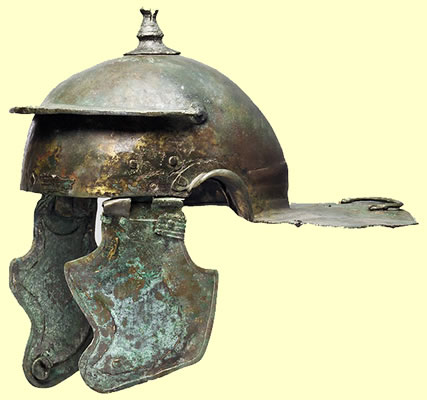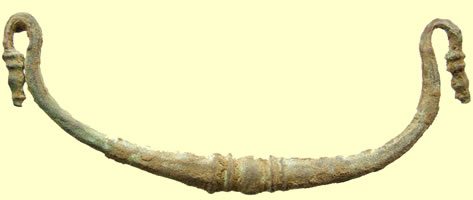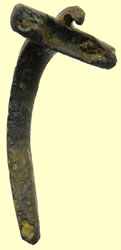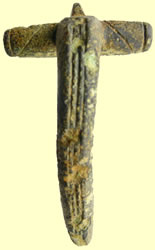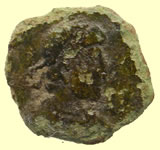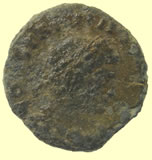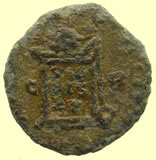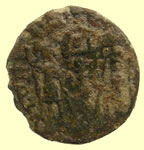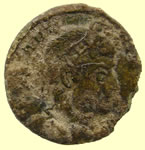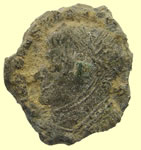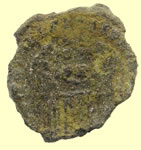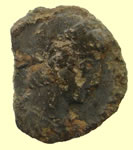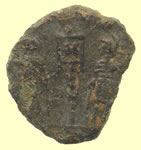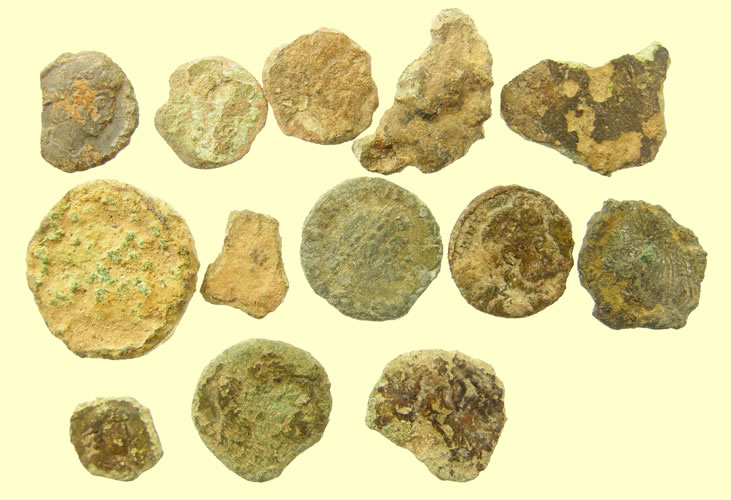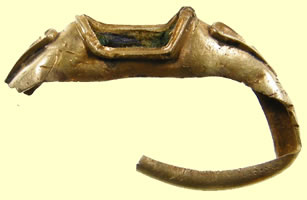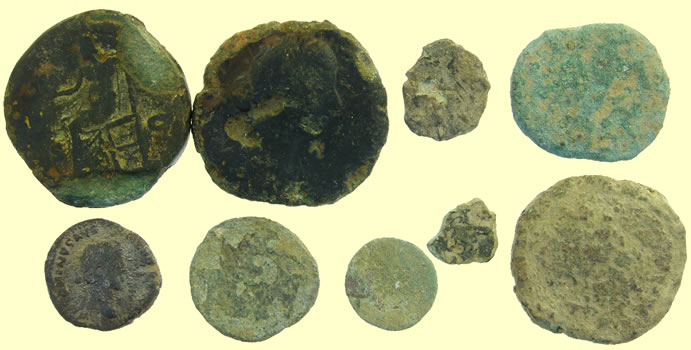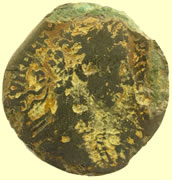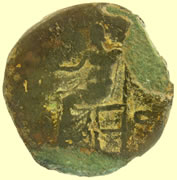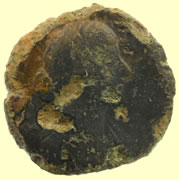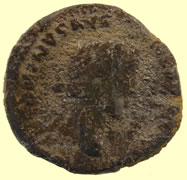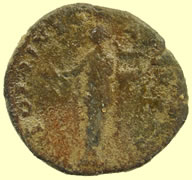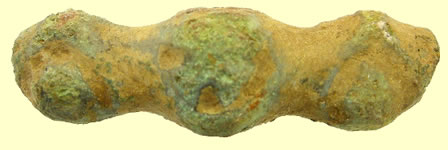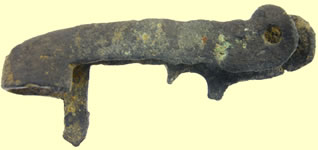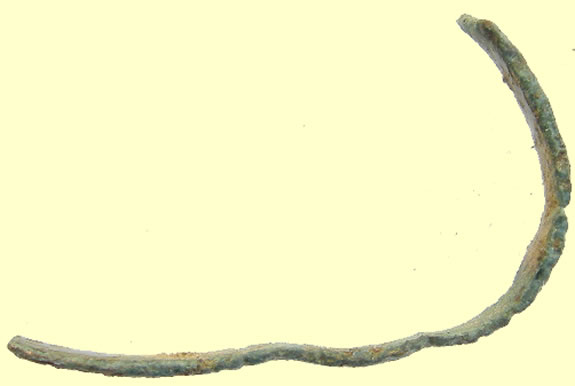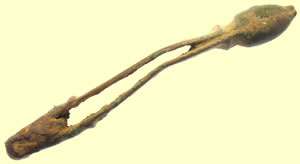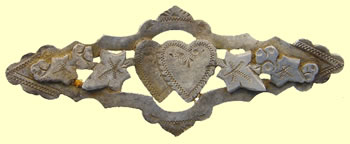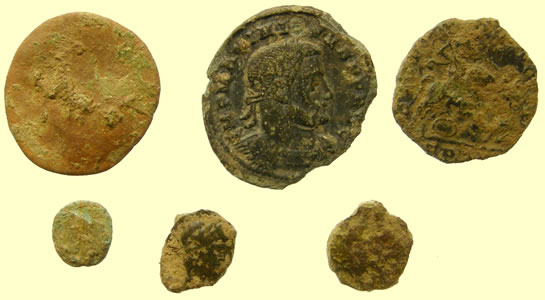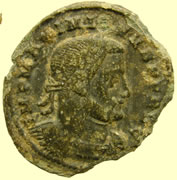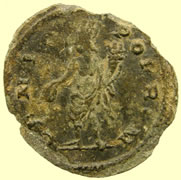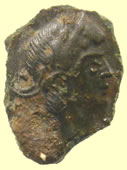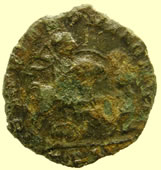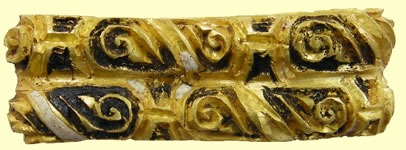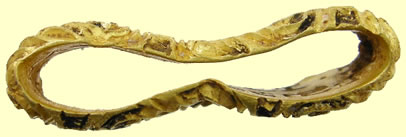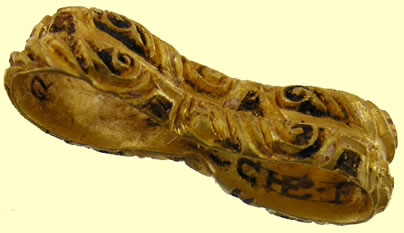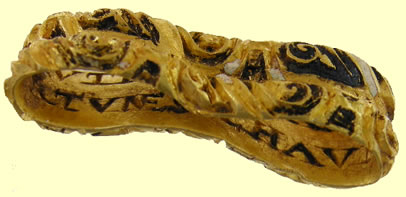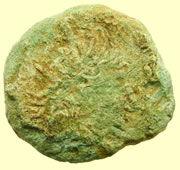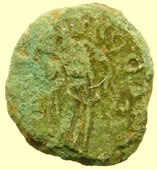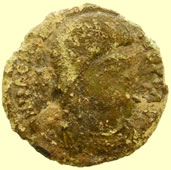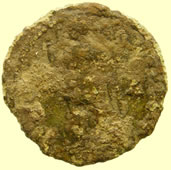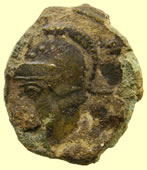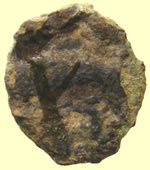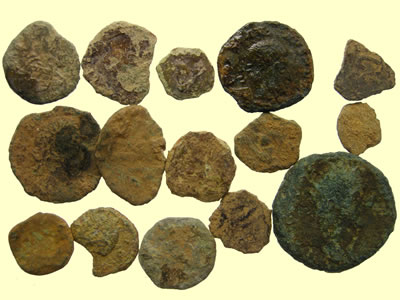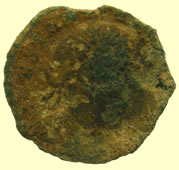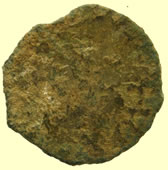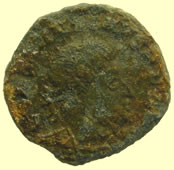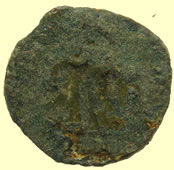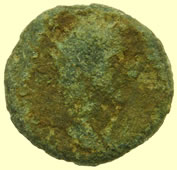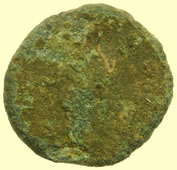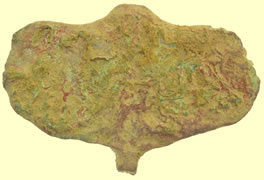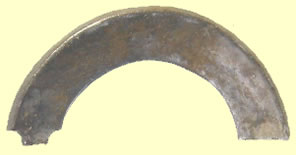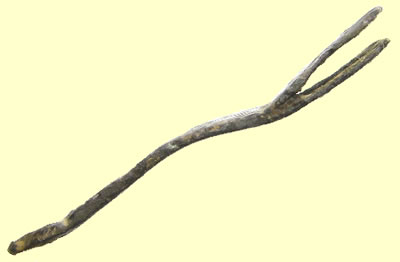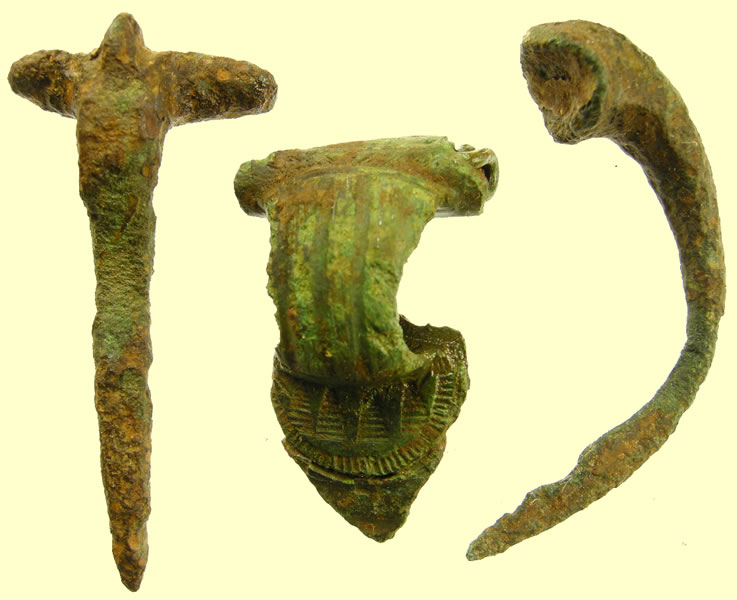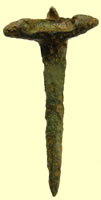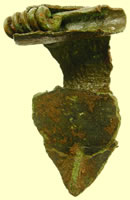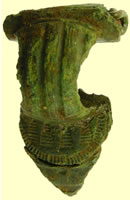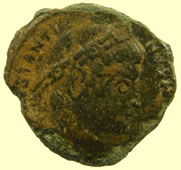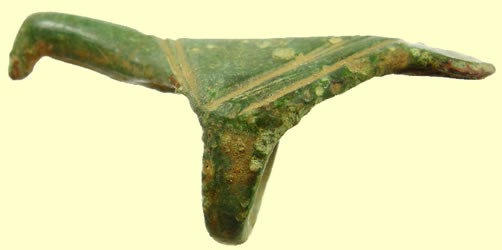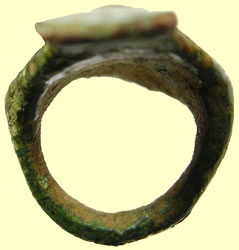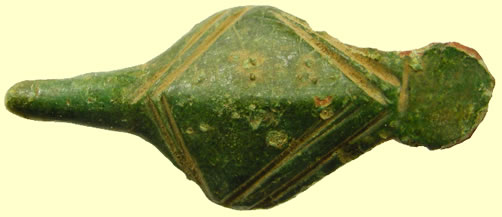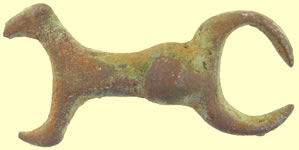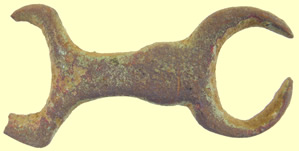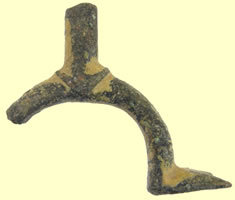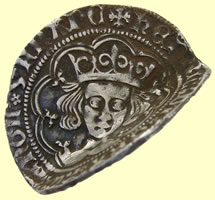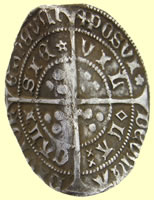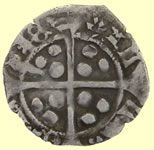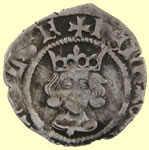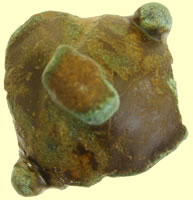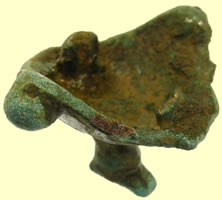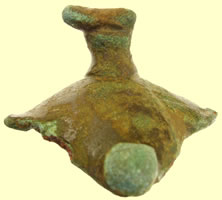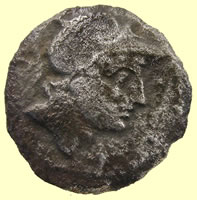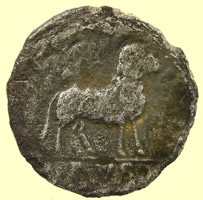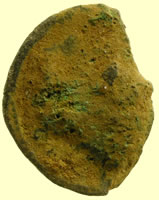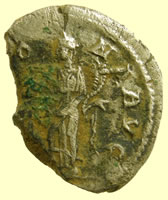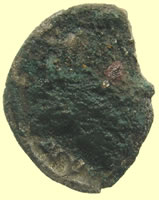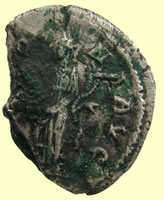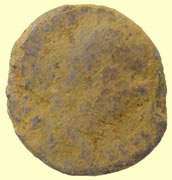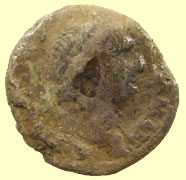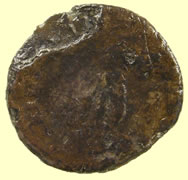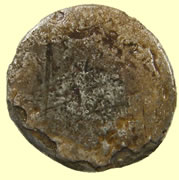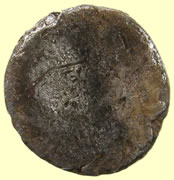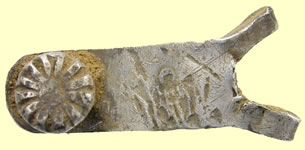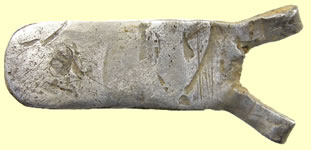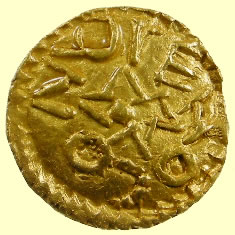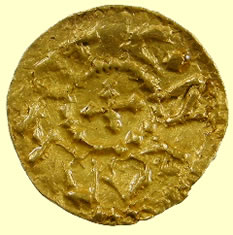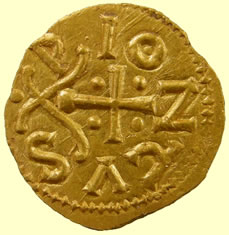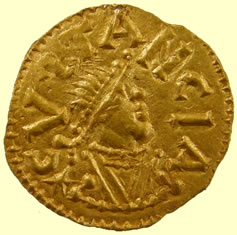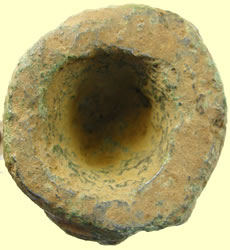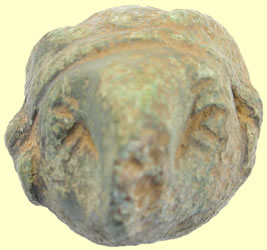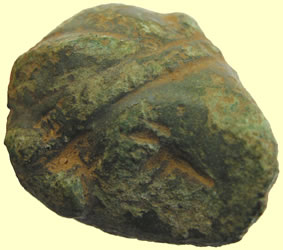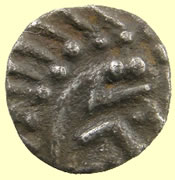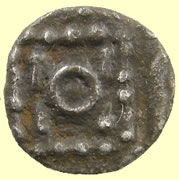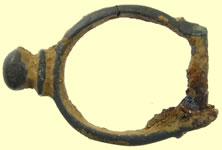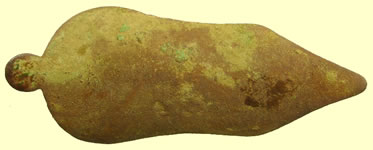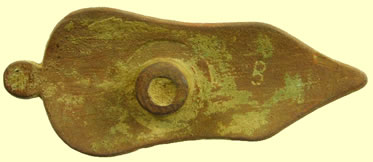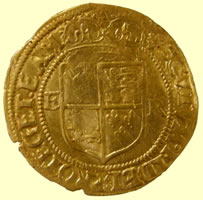

Metal detecting holidays in England with the World's most successful metal detecting club.
Twinned with Midwest Historical Research Society USA
2010 March Finds Page |
1stC AD Weisenau type helmet - they have the distinctive carrying handle on the neck guard
Roman helmet handle 14.08g, 87.42mm L |
|||
1st C Roman fibular brooch 13.14g, 50.51mm |
|||
4thC Roman bronze coins
|
|||
Potential Roman bronze coin hoard found - reported to Col;chester mueum
The piece with the short altar on the reverse is a BEATA TRANQVILLITAS - these date to about 320, they're the series just after the VLPP's. It seems to say CONSTANTINE on the obverse, but could be either Constantine I or son Constantine II, I can't see the end of the legend and that would tell us whether it was Constantine I (AVG), or II (NOB C) - The letters in the field - C - R on either side of the altar allow me to attribute it to the mint of Lugdunum (Lyons). - here's an example of a similar type from the mint of London - http://www.stoa.org/gallery/album164/34_Constantine_II_BET_LON
The other piece with a clear reverse is another 1-standard GLORIA EXERCITVS - I can make out "...STANT..." on the obverse, which rules out only Constans and Delmatius - it could be any other member of the Constantine clan - and again, I can't see the end of the legend which would allow me to narrow it down between a Caesar or an Augustus. (Pretty much the same list in either case, since all 3 of Constantine's sons became Augustii on his death in 337 - all 3 had been Caesars previously).
The piece for which you sent only the obverse image has no visible legend, but the portrait tends to look the way Constantius II tended to be portrayed on his FEL TEMP REPARATIO (soldier spearing fallen horseman - I'm sure you're familiar with these - they're probably the most common coin-type of all antiquity). You must understand, this is 90% guesswork when I'm seeing only an obverse portrait of this era with no legend and no part of the reverse.
So far, with the exception of the larger pieces you sent yesterday, just about all this material dates to the Constantinian era - but over a fairly broad span of years, say 315-360. This is a little later than most of the coins you've shown me from your other, earlier dig-sites, although your last "hoard" of Magnentius/Decentius Centenionales came from a specific bit of the same general era.
Mark
the "D" shaped one (# 5, I believe) is a GLORIA EXERCITVS - "(to the) Glory of the Armies" - with a single standard between the 2 soldiers, it dates to the period 335-340. They were struck for the entire Constantine clan and a couple cousins, besides, so without some pretty clear letters on the obverse, it's difficult to tell who was intended to be portrayed. I can, I think, make out the bottom seriphs of "...AVG" at the end of the legend, so that narrows it down to 4 possible suspects - Constantine I & II, Constans and Constantius II - with no real way to tell who it is.
This one might have looked something like this, originally - http://www.stoa.org/gallery/album165/67_Constantine_I_GE1_ANT
The very irregularly shaped one (# 4, I think) dates to around 320 AD - these were struck for Constantine I, his oldest son Crispus, and the two Licinii. These are known as "VLPP's" - the reverse (VICTORIAE LAETAE PRINC PERP) shows 2 Victories, face to face, resting a shield inscribed "VOT / XX" on a short altar. I'm pretty sure this one shows Constantine I - or at least that's what the fragments of legend between about 8:00 & 12:00 on the obverse lead me to believe.
It would have looked like this, originally - http://www.stoa.org/gallery/album164/02_Constantine_I_VLLP_TIC - although the bust faces the opposite direction.
There isn't enough of their lower reverses visible to tell which mint they might have come from.
Mark
|
|||
 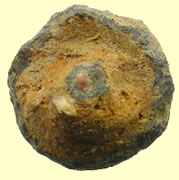 |
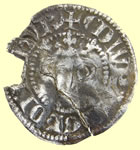  |
||
Roman face mount |
1279 Edward 1st hammered silver penny - type 10ab Obv EDWAR R ANGL DNS HYB Rev CIVI/TS/LON/DON - London mint |
||
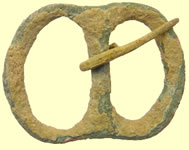 |
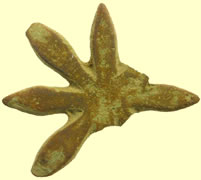 |
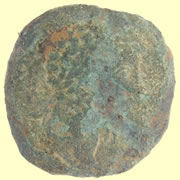 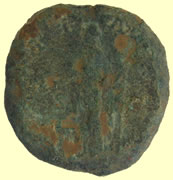 |
|
1550-1650 buckle |
Incomplete medieval spur rowel |
1stC Roman bronze coin sent for ID- non hoard coin |
|
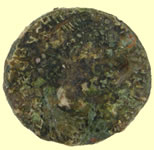 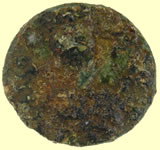 |
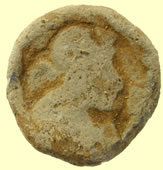 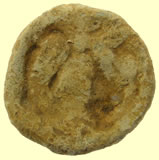 |
||
4th C Roman bronze coin sent for ID - non hoard coin |
Roman lead token |
||
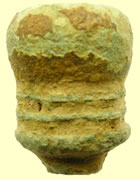 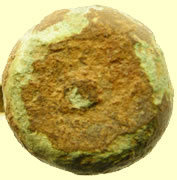 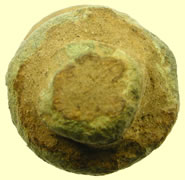 |
|||
Romano/British bronze widget - not sure of use yet |
|||
Romano/British Ancient gold ring - reported as treasure to the museum 1.53g, 26.17g |
|||
Mass Gary's hoard coins
1stC Roman bronzes with detail sent off for ID Sestertius of Commodus, son of Marcus Aurelius, (177-192) 16.21g, 29.88 - As or Dupondius of Faustina II, wife of Marcus Aurelius, 12.85g, 27.76mm
Roman silver coin sent off for IDAntoninus Pius (138-161) 2.92g, 17.49mm The denarius seems to be Antoninus Pius (138-161), I'm not certain about the reverse type yet, but it might be a Fortuna type, I seem to make out "FORTVNA" on the left. Antoninus was a prolific producer of types, we'll need to be able to read at least a few letters of the legend on the reverse to be more sure.
"#6" is a sestertius of Commodus, son of Marcus Aurelius, (177-192) the reverse appears to be Salus - what you don't see is the branch she's holding out over a serpent rising at her feet.
"#7" appears to be an As or Dupondius of Faustina II, wife of Marcus Aurelius, All I have to go on, to distinguish between her, Lucilla and Crispina is the solitary "F" at 7:00 obverse, which seems to be all that remains of the obverse legend. I'm afraid that with a coin so compromised, it's not easy to be certain, but my best guess is Faustina the Younger.
Mark
|
|||
 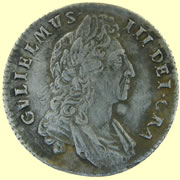 |
 |
||
Crisp 1697 William III milled silver shilling |
Roman harness cheek pice |
||
|
|||
Roman decorated buckle fragment - some gilding remains |
|||
  |
|||
Large decorated Roman bronze cotter pin |
|||
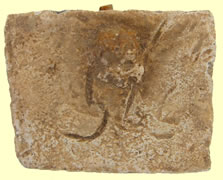 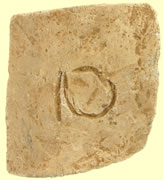 |
 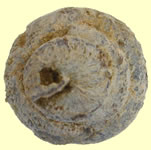 |
||
Interesting 2 inch sq lead numbered tags |
Roman lead gaming token |
||
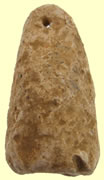 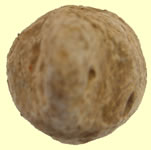 |
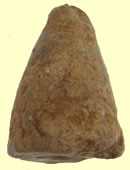 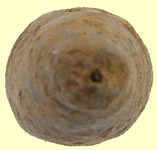 |
||
Roman lead hanging weight |
Medieval lead gaming token |
||
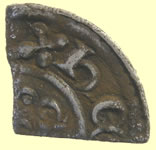 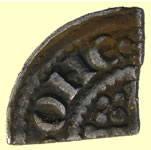 |
|
||
1247 Henry III hammered silver shortcross qtr penny Obv HENRICVS REX Rev **ON C *** - canterbury mint |
Interesting early widget ? no idea of ut's use yet |
||
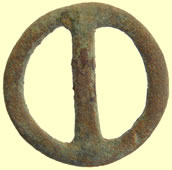 |
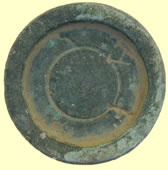 |
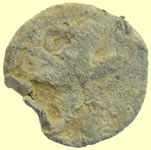 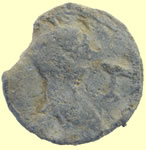 |
|
Medieval annular buckle |
George 1st trade weight - Crown G London hall mark |
Roman lead token |
|
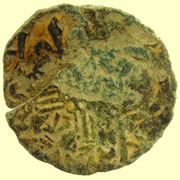 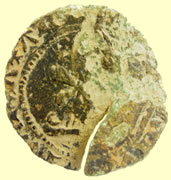 |
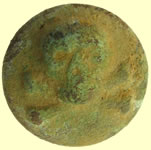 |
 |
|
1340 AD Medieval French Jetton |
WWII Tank regiment button |
Roman buckle tongue |
|
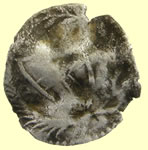 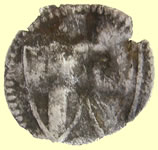 |
  |
||
1649 Commonwealth hammered silver penny |
1247 HENRY III hammered silver voided long cross half penny Obv HENRICVS REX Obv NICOLE - Moneyer Nicole of London |
||
|
|||
Very interesting heavily decorated and gilded Roman piece - could be a broken ring
|
|||
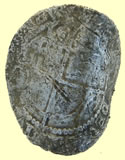 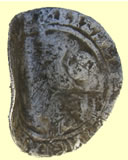 |
 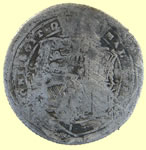 |
||
1560 Elizabeth 1st hammered silver 3 pence - with rose and date |
1816 George III milled silver sixpence |
||
|
|
||
Interesting knife handle - not sure of date - one for the museum |
1881 Victorian Chester hall marked silver brooch Maker - FSB |
||
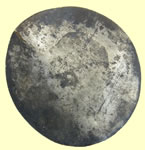 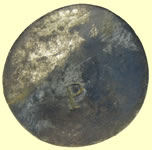 |
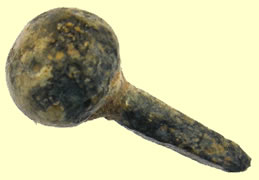 |
||
18thC George II milled silver sixpence - overstamped P |
Roman pin head |
||
 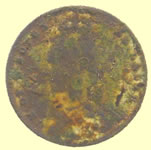 |
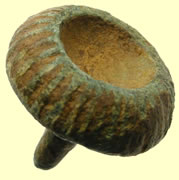 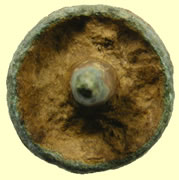 |
||
Victoria model farthing |
Roman baldric mount |
||
Boston Beau's Roman hoard coins
Roman bronze sent for ID 3.48g, 25.88mm The larger one with good detail (#8) is pretty easy - that's Maximian, Diocletian's partner in founding the first Tetrarchy at the end of the 3rd century. It's a Follis, and the type is "GENIO POP ROM" - the "Genius" (meaning more like "spirit" than anything to do with MENSA) of the Roman People. This is an interesting type - it's about the only follis of this kind with no mint mark - which means, in this case, it's from the mint of London, c. 300-303.
#9 seems to have the legend "GLORIA ROMANORVM" - which should be a big help, except that this legend is used over and over by many rulers over centuries. Checking a particularly helpful on-line reference, I find that if the design is what I think it is -
"Emperor on horseback, galloping right, spearing barbarian with outstretched arms kneeling left beneath or in front of the horse; shield and broken spear beneath horse" - here's a none-too-clear example from my collection: http://www.stoa.org/gallery/album167/28_Magnentius_GLO_AQL
- and about all I have to go on for certain is the shield at the bottom, the fact that's it's a "busy" design, and the mint mark - "TRP" (Trier mint) - with this legend, if it is this type, it can only be Magnentius - a short-lived emperor in the 350's, promoted from general to the purple in the field by his troops - the last hoard you had was deep in Magnentius and his brother Decentius. His legitimacy as an emperor and popular support was mainly centered in the Western part of the Empire.
#10 is just a face - unfortunately, as nicely crafted as this example is, by the end of the 3rd century, the "photo-realism" of earlier centuries was gone. Now, the engravers were generally struggling to make the obverse portrait look like "a person" - unfortunately, not a specific person, just a more or less generic human, so except for a few notable exceptions, you just can't tell who was intended if there's no legend, no reverse, etc. The fact that the headgear is a laurel-wreath instead of a diadem places it at least before the death of Constantine I (337) when the imperial diadem completely replaced the laurels of an earlier age.
Mark
|
|||
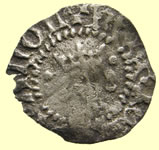 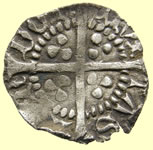 |
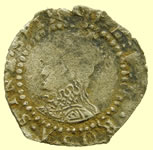 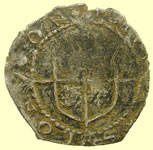 |
||
1422 -61 Henry VI hammered silver half penny - roundabout Initial cross- pellets by crown Possible satire leaf issue Obv HENRIC REX ANGLI Rev CIVI/TAS/LON/DON - London mint |
1582 Elizabeth 1st hammered silver penny - Sword mintmark |
||
|
|||
Another Roman decoated bracelet find (top) similar to the piece found earlier in the week from the same field |
|||
  |
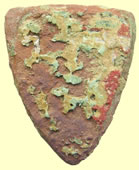  |
||
1603 -4 James 1st hammered silver half groat - 1st issue |
C13thC Medieval heraldic shield mount - traces of red and white enamel remains |
||
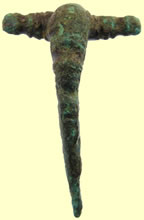 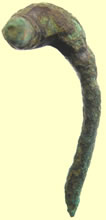 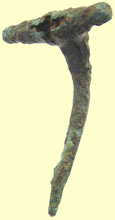 |
|||
Stunning 1st C decorated fibular brooch |
|||
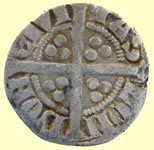 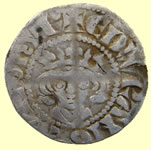 |
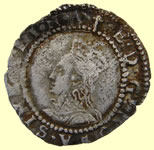  |
||
1341 Edward III hammered silver penny - Florin issue Obv EDWAR ANGLE DNS HYB Rev CIVI/TAS/LON/DON - London mint |
1582 Elizabeth 1st hammered silver penny -Sword mintmark |
||
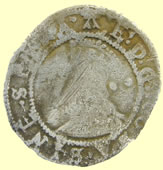 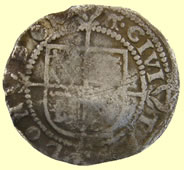 |
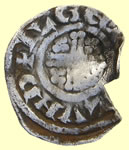 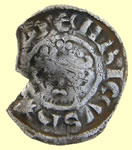 |
||
1582-4 Elizabeth 1st hammered silver half groat (2 pence) A mintmark |
1199AD King John hammered silver short cross penny - 5b Obv HENRICVS REX Rev ILGE(B + LVND - Moneyer Ilger of London mint |
||
|
|||
Medieval gold ring - reported as treasure to the museum Stunning Black and white enameled gold ring - double banded with inscription on both upper and lower bands.5.83g, 25.91mm L x 8.40mm W Top legend -LEI TRVTEE ADVANCE Bottom legend - ECHE . FORTVNES CHAVNG |
|||
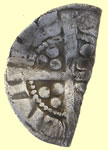 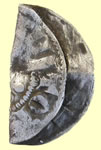 |
|||
Taco'd Medieval hammered silver penny - need fixing to read obv face Rev CIVI/TAS/CAN/TOR - Canterbury mint |
|||
Mass Linda's Roman hoard coins
Coin 20 (Mid 3rdC)-------------------------------------------------------- Coin 21 (350-353AD)
The piece with the short altar on the reverse is a BEATA TRANQVILLITAS - these date to about 320, they're the series just after the VLPP's. It seems to say CONSTANTINE on the obverse, but could be either Constantine I or son Constantine II, I can't see the end of the legend and that would tell us whether it was Constantine I (AVG), or II (NOB C) - The letters in the field - C - R on either side of the altar allow me to attribute it to the mint of Lugdunum (Lyons). - here's an example of a similar type from the mint of London - http://www.stoa.org/gallery/album164/34_Constantine_II_BET_LON
Coin 22 (330-337 AD) Roman coins sent off for ID Coin # 20 appears to be a contemporary copy of a mid-3rd century antoninianus. Some folks call these "Barbarous Radiates", although I think that's a completely inappropriate name and mindlessly continues the narrow-minded artistic prejudices of our Victorian forbears. The folks who made and used these coins were no more barbarians than were the makers and users of the coins which they copied - in fact, they tended to be the most civilized residents of an area. These coins typically were an "emergency currency", not unlike Conder Tokens or US Civil War or Hard Times Tokens. When no official coin is reaching an area the economy of which is normally facilitated by commonplace use of coinage, local substitutes - usually in imitation of familiar types - almost inevitably arise. These pieces were not made to decieve, (and so are NOT "counterfeits"), rather to take the place of Regal Coinage which had become unavailable due to hoarding and/or attrition.
This piece is not in good enough condition for me to be sure what was being copied, although the "PAX AVG" and "SPES AVG" reverse types were overwhelmingly popular on 3rd century contemporary copies and the standing figure's raised arm might be holding an olive-branch or a flower. It appears from the seeming string of "O's" in lieu of legend visible around 1:00-4:00 on the reverse, that this may be a contemporary copy of a Roman type by an illiterate or semi-literate neighboring group - it was common for legends to be reduced to a design element when coins were copied for this purpose - as a supply of coins for trade purposes to semi-Romanized local peoples who had become familiar with the use of coin.
Date this one to approximately 265-275 AD.
Coin # 21 seems to be of a 4th century Caesar. It was common at that time to distinguish between emperors and Caesars by the headgear on their coin portraits. This is a bare-headed bust, and so you'd think it must be a Caesar. However, the legend ends in "...AVG", and there is one Augustus who often appears bare-headed, Magnentius. So my best guess on this one is a Centenionalis of Magnentius with a FELICITAS REIPVBLICAE reverse type - the emperor standing left, holding a small figure of Victory and a labarum. Magnentius was around for only a brief time, 350-353 AD.
Coin # 22 is a "City Commemorative" - when Constantine moved his capital to Constantinople c. 330, there was a very large issue of small folles commemorating both Constantinople and Rome. This is an VRBS ROMA - with helmeted Roma facing left on the obverse and the mythic Shewolf standing left on the reverse suckling Romulus and Remus. These belong to the period 330-337 or so.
None of these has any legible mint marks (not that the mint mark would mean anything on the contemporary copy) so I can't tell where they were minted.
Mark
|
|||
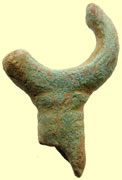 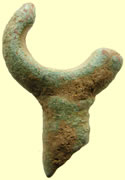 |
 |
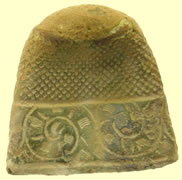 |
|
Saxon harness fitting |
18thC clog fastner |
Georgian decorated thimble |
|
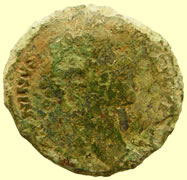 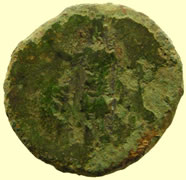 |
|||
| Non hoard Roman coin sent for ID Quick reply is that it's a sestertius of Marcus Aurelius as Caesar (138-161) under Antoninus Pius. Not sure what the reverse type is yet, the figure is in "military garb" but I don't recognize the pose right offhand - I'll look more closely later.
Mark
I spent a good deal of time trying to run this one to ground - and didn't quite satisfy myself as to who, what and when it is, but I can tell you generally what it has to be. On the basis of the un-bearded-looking chin, in order of likelihood, this is a sestertius of A) Antoninus Pius, B) Marcus Aurelius, C) Commodus. Although all three tended to sport beards, all three began with either very tightly cropped beards or bare chins - Antoninus, however, kept his beard short and trim throughout his reign. All three used legends at some point in which ANTONINVS appears early in the obverse legend - Antoninus througout his reign. M. Aurelius as Caesar (ie: short beard) seldom, but as Augustus, nearly always (but always with a long, pointy or even scraggly-looking "Philosopher's beard" as Augustus.) Commodus, whether early or late in his reign, very seldom, but not "never".
So, as you can see the indicators point towards Antoninus Pius (although I believed it was M. Aurelius Caesar or even Commodus from the portrait) for the obverse.
The reverse has a figure dressed in "Military garb" standing, either left or facing. presumably holding something in that upraised hand and perhaps cradling a short object in the left elbow. Figures of Virtus / Roma in military garb abound for all three - here's an example of a Virtus reverse for M. Aurelius as Caesar - http://www.stoa.org/gallery/album94/M_Aurel_Caes_Virtvs_Sest1 - Virtus is not in the same pose, but dressed similarly and holding a short(ish) object, the parazonium, in the crook of the arm (albeit, the right arm). There is also a type common to all 3 of "The Emperor in military garb standing..." but usually with easily identified attributes - Spears, Standards, Leaning on Shields, etc.
After going through RIC III page-by-page for the whole Antonine Dynasty, I did not satisfy myself that I had found "The Type" beyond question, but there were many examples for which the ambiguous bits of legend and/or types on this coin could be made to fit. More for Antoninus than for the other suspects. So, in the interest of getting something else done today, I'm going to cut my losses and say "Probably Antoninus Pius and probably Virtus/Roma on the reverse" This places us somewhere between about 140-160 AD. - but those are the same years as for M. Aurelius as Caesar, and M. Aurelius Augustus shared the purple with his son Commodus from about 175-180, but Commodus was also Caesar from 166-176 (and would have had a bare or barely bearded chin), so you can see there's a LOT of potential overlap of era here.
Basically, it's really too bad that there isn't more clear legend on the obverse and/or in addition to the S-C on the reverse.
Mark
30.92mm, 16.06g
|
|||
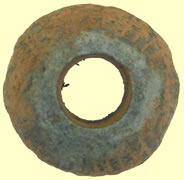 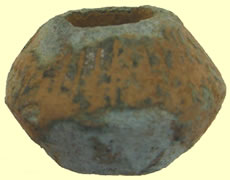 |
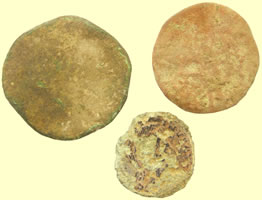 |
||
Roman bronze decorated spindle whorl |
Mass Steve's Roman hoard coins - all illegible |
||
  |
|||
Huge 17thC - 6 inch long mount with integral lugs |
|||
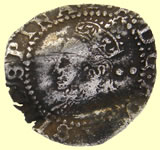 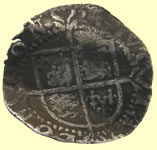 |
 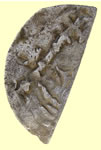 |
||
1602 Elizabeth 1st hammered silver half groat - 2 mintmark 7th issue |
1154 Henry II 'Tealby' hammered silver half penny Cross and crosslet type |
||
  |
 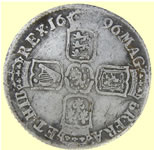 |
||
1422-27 Henry VI First reign hammered silver penny Annulets by neck, annulets in centre of pellets in 2 qtrs Rev VILLA/CAL/ISIE - Calais mint |
1696 William III milled silver sixpence |
||
 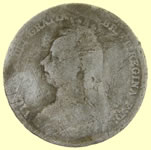 |
 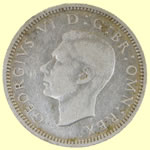 |
||
1891 Victoria milled silver sixpence |
1940 Georghe VI milled silver sixpence |
||
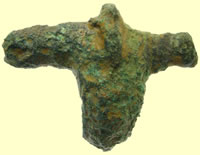 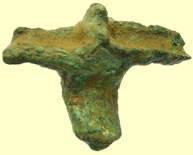 |
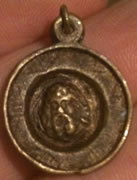  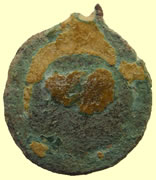 |
||
1stC Roman fibular brooch |
14thC John the Baptist medallion |
||
Mass Steve's 18 Roman hoard coins sent for ID # 25 appears to be a Dupondius of the Antonine Era - I believe I see the points of a radiate crown on the portrait, the size and weight are consistant with dupondii of that era. Most likely Antoninus Pius (138-161) - the reverse is too far gone to say more than that it's a standing figure - the reverse legend seems to end in "...COS III" dating it, most likely, to the time of Antoninus' 3rd consulship, 140-145 AD. It might be COS III, however, in which case, it would date it from 145-161.
#23 & # 24 are both Constantinian-era pieces, both Folles -
on # 23 I can make out "...CONSTAN..." on the obverse and not very much else - I can't figure out what the reverse is doing - 4 members of the Constantine clan are potential suspects (Constantine I & II, Constans & Constantius II) - without knowing the reverse type, I can only estimate a date roughly, say 315-325 AD.
# 24 has a little more going for it, I'm pretty certain that it's Constantine I, and since the reverse type is one of the IOVI CONSERVATORI series of reverses with Jupiter standing left, holding a small figure of Victory, on a piece of this size, you can say approximately 313-318 AD. with some confidence.
Mark
|
|||
  |
 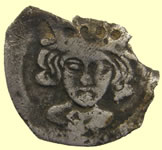 |
||
1634 Charles 1st hammered silver half groat - Group D CR by shield Aberystwyth mint - single pellet |
1476 Edward IV (Durham) hammered silver penny - D at centre of reverse cross |
||
 |
 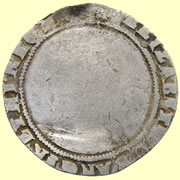 |
||
17thC Norwich series lead 1/4 pound trade weight |
1575 Elizabeth 1st hammered silver sixpence |
||
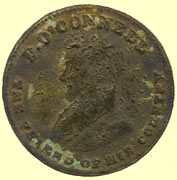 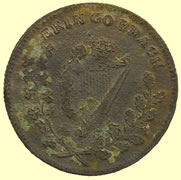 |
  |
||
19thC D.O'Connell 'The friend of the country' token |
1247 Henry III hammered silver short cross half penny Rev **CAN - Canterbury mint |
||
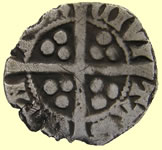 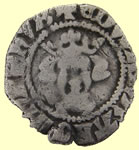 |
  |
||
1341 Edward III hammered silver florin penny Obv - EDWAR R ANGL DNS HYB Rev CIVI/TAS/CAN/TOR - Canterbury mint |
1stc Roman fibular brooch - casting flaw |
||
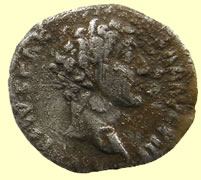 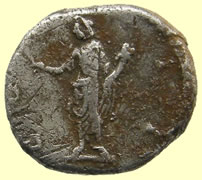 |
  |
||
Roman silver coin send for ID This is a denarius of Marcus Aurelius as Caesar under Antoninus Pius. Do you notice you've been finding a LOT of Antonine-era and Constantinian-era material - and very little Severan or late 3rd century material? It seems this site must have had a couple of population or activity peaks - one in the mid 2nd century and one in the early-mid 4th century. There seems to be a gap - at least in the coins you're finding - of a century and a half to two centuries. That's if this all has been coming from the same site, of course.
The obverse legend is AVRELIVS CAESAR AVG PII F, M. Aurelius' bare head right. The reverse reads (I believe) COS II - meaning that he's now in the office of consul (sort of like "President" or "Prime Minister") for the second time - since all we can see is "CO...II" it might also be COS DES II meaning elected but not yet inaugurated - making a difference of a couple months and placing it in the previous year (144.) The device is Honos standing left holding a branch and a cornucopia - this type is known for both COS II & COS DES II. As far as I can tell, this is a product of the mint at Rome in AD 145 (but maybe 144).
Mark
|
Medieval seal matrix |
||
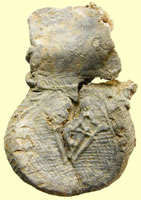 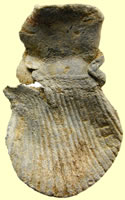 |
 |
||
Medieval lead pilgrims ampulla - Salisbury type |
Medieval beehive thimble |
||
 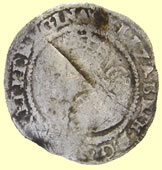 |
|
||
1559 Elizabeth 1st hammered silver three pence |
Good call by Mass Linda on a Roman tendril pendant she found last week in the Laycock book Fig A14.7 |
||
 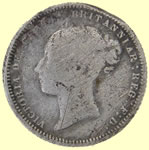 |
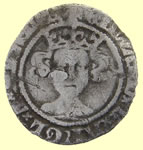 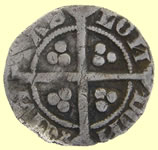 |
||
1872 Victoria milled silver sixpence |
1369-1377 Edward III Post -treaty hammered silver penny Satire before CIVI, satire stops on Obv legend Obv EDWARD REX ANGL F FRANC Rev +CIVI/TAS/LON/DON - London mint |
||
|
 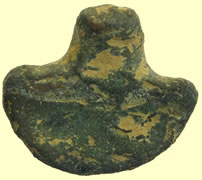 |
||
19thC snake buckle |
Roman mount |
||
|
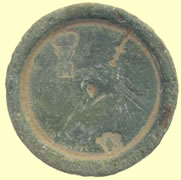 |
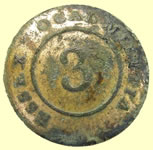 |
|
Possible Roman silver treasure - reported to museum-
0.99g, 19.84mm dia |
Excellent 17thC William and mary trade weight - Crown WM cipher London hallmarks |
19thC 3rd Essex Militaria button |
|
 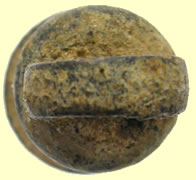 |
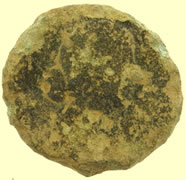 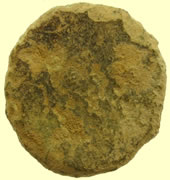 |
||
Very unusual Geogian bell type trade weight |
1stC Roman bronze sent for ID |
||
 |
 |
 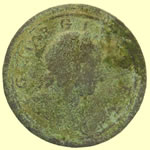 |
|
1550-1650 buckle |
Medieval mount - single rivet fixing |
1724 George 1st milled copper farthing |
|
 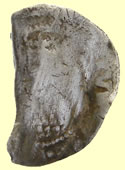 |
 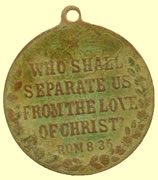 |
||
1603 James 1st hammered silver half groat |
Victorian pendant
'God is our refuge and strength' 'Who shall separate us from the love of Christ'
|
||
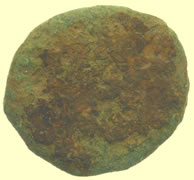 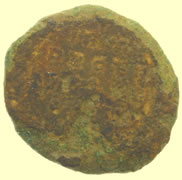 |
 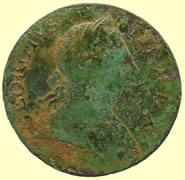 |
||
1stC Roman bronze sent for ID - interesting lettering on obv |
1773 George III milled copper halfpenny |
||
 |
 |
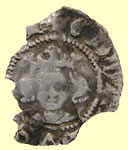 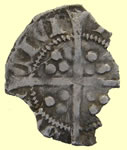 |
|
Lead toy horse |
Georgian spur buckle |
1340 Edward III hammered silver penny Rev CIVI/TAS/LON/DON - London mint
|
|
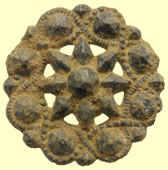 |
 |
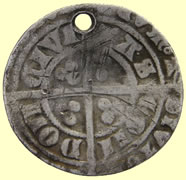 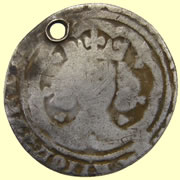 |
|
16thC Tudor mount |
20thC Malted drink badge
'The league of Ovalteneys' |
Interesting , never seen a half groat used as a pendant 1351-1361 Edward III hammered silver half groat Obv EDW***REX DNS.F.FRANCI Rev CIVI/TAS/LON/DON - London mint |
|
 |
  |
||
Roman pendant |
17thC mount with 2 integral lugs |
||
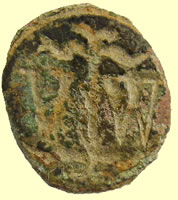 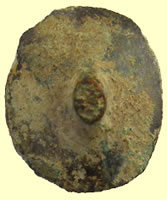 |
  |
||
13thC seal matrix - VW |
1247 Henry III hammered silver half penny Moneyer Nicole of Canterbury mint |
||
 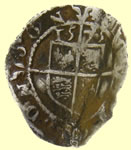 |
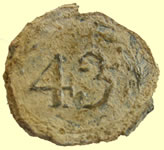 |
 |
|
1575 Elizabeth 1st hammered silver penny |
18thC 43rd Regiment of foot button |
WWII Royal airforce button |
|
 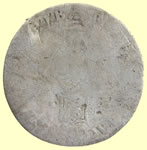 |
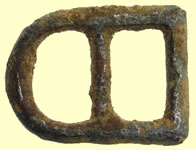 |
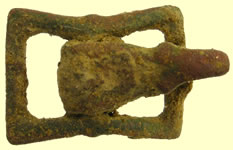 |
|
1696 William III milled silver sixpence |
1550 -1650 buckle |
1550 -1650 buckle |
|
|
|||
7th century Saxon dragon headed silver strapend - reported as treasure to museum
35.89mm L, 2.61g |
|||
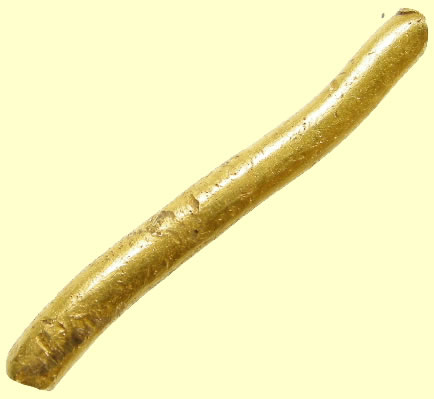 |
|||
Ancient gold ingot - possible wrist or ankle torc fragmetn3.48g, 3.45mm dia , 29.86mm L- reported as treasure to museum |
|||
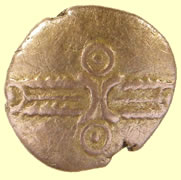 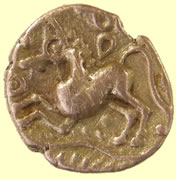 |
|
||
1stC BC Celtic gold qtr stater - Eastern gold attributed to Dvbnovellaunos tribe Sent to CCI for recording 1.34g,11.67mm Hobbs 2442 Page 146 Colchester find |
Rare find - 1stC BC to 1stC AD Celtic cosmetic decorated wode grinder |
||
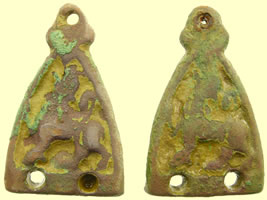 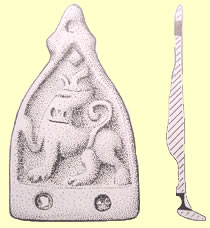 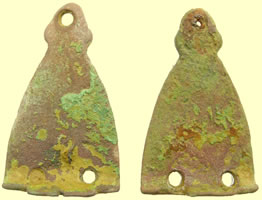 |
|||
2 - Late Saxon c10thC stirrup strap mount Class A Type 11a Sub tringular mount depicts a Lion looking upwards with its front paw raised and tail curled between its legs and over the back |
|||
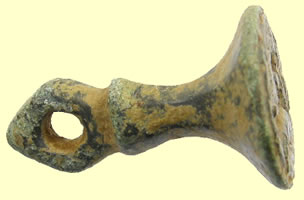 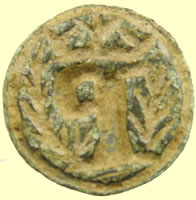 |
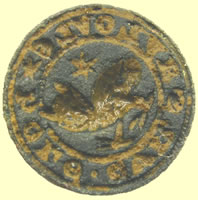 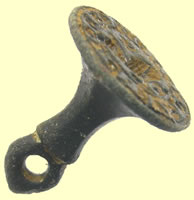 |
||
15thC traders seal matrix - IR inscription |
Stunning medieval seal matrix - needs more cleaning to decipher legend |
||
 |
 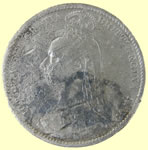 |
||
The Linconshire regiment button |
1889 Victoria milled silver sixpence |
||
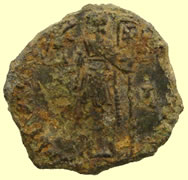 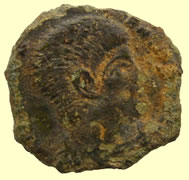 |
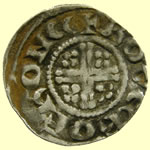 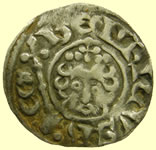 |
||
Another Roman hoard coin sent for ID 20.22mm, 3.47g
That, like the majority of the pieces from the hoard you found a few months back, is our old friend Magnentius. The combination of the mullet on the portrait and a slighly scarcer reverse type - FELICITIAS REIPVBLICE, emperor standing left holding Victory and labarum - plus an unusual obverse legend - discernable by the "EN" at 1:00 obv - allow us to tell that it's from the mint at Trier, despite the missing exergual mint mark. The short-lived Magnentius and his brother Decentius were only around for a couple years, 350-353 AD.
This piece has essentially the same type of reverse, unfortunately it's hardly more legible than the reverse on yours http://www.stoa.org/gallery/album167/27_Magnentius_FEL_AMB
Mark
|
1216 Henry III hammered silver penny Class 7a Obv HENRICVS REX Rev ROGE( OF B ON C- Roger of Canterbury |
||
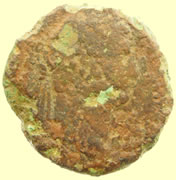 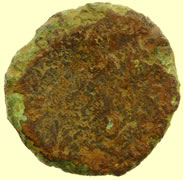 |
 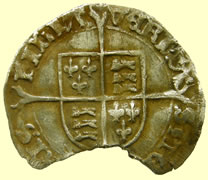 |
||
Non hoard Roman bronze sent for ID 29.76mm, 16.03g This one will be from a different occupation horizon that most of what you've been digging recently. It's not easy to be sure with the condition it's in, but I believe that's a mature-bust portrait of Hadrian - so we're looking at c. 125-138 AD. 200 years, give or take, before the Constantinian-era material which has been the majority of what you seem to be finding at your "village" site.
It's interesting, overall, that you almost never seem to find any 3rd century / Severan Dynasty material - on this or any of your other sites. It's as though the area was abandoned for a century-plus between the late 2nd century and the early-mid 4th century.
Mark
|
1554 Mary hammered silver groat (4 pence) |
||
 |
|
||
Victorian silver can band |
Medieval decorated mount |
||
  |
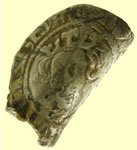 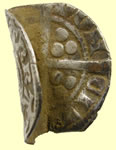 |
||
1341 Edward III hammered silver penny Obv *** ANGL DNS HYB Rev CIVI/TAS/LON/DON - London mint |
1341 Edward III hammered silver penny Obv EDWAR R ANGL DNS HYB Rev CIVI/TAS/LON/DON - London mint |
||
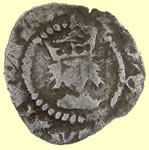 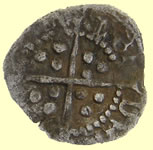 |
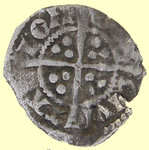 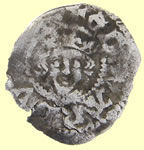 |
||
1509 Henry VIII hammered silver halfpenny - 'Brush hair' bust - Cross fourchee Rev CIVI/TAS/LON/DON - London mint 0.27g, 11.07mm |
1279 Edward hammered silver farthing - New issue with inner circle both sides - Type 28 Obv +EDWARDVS REX Rev CIVI/TAS/LON/DON - London mint 0.32g, 11.16mm |
||
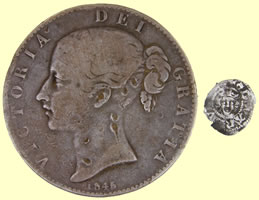 |
|||
Size comparison of a Victorian crown and medieval farthing |
|||
  |
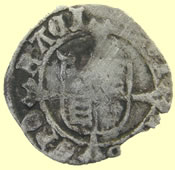 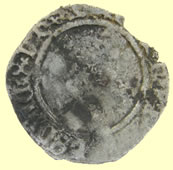 |
||
1216 Henry III hammered silver voided longcross cut 1/4 penny |
1554-47Henry VIII hammered silver half groat - Third coinage - spur from shield to inner circle 18.93mm,0.81g Rev CIVI/TAS/EBO/RACI - York mint |
||
 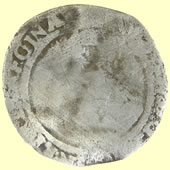 |
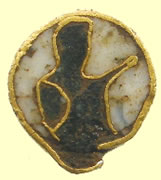 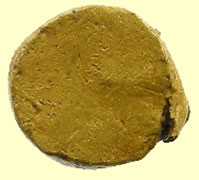 |
||
1567 Elizabeth 1st hammered silver three pence |
Ancient gold ring bezel ? -cloisonné enamel-work - probably Roman - reported to museum as treasure 1.25g, 9.84mm dia |
||
|
|||
3 beauty Roman fibular brooches 1stC Colchester type two piece - 1stC Rosette brooch |
|||
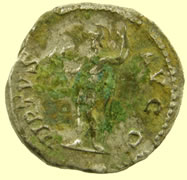 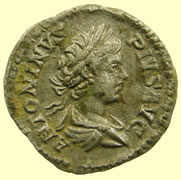 |
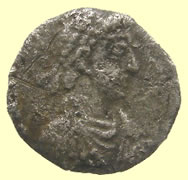 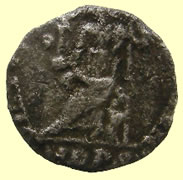 |
||
Best condition 2nd C Roman silver coin I have seen dug - sent for ID 2.89g, 18.95mm Of course, just as soon as I comment that you never seem to find any Severan Dynasty material, the very next coin you send me is right in the thick of the Severan Era. This denarius is of Caracalla - as a young man, obviously - he was elevated to the status of co-emperor alongside his father, Septimius Severus, at about the age of 10 in 198. This denarius, from the main mint at Rome, was struck c.203. The reverse type, VIRTUS AVGG, has Virtus (or Roma - it's somewhat ambiguous who was intended) standing left holding a small image of Victory and a spear.
(RIC IV 149, RSC 665a, SR 6903)
As for the condition - sure, I suppose it might have been in a pot which has only be broken open by agricultural action in very recent times. This is relatively good silver (maybe 50-60% or better) so would be far less liable to corrosion than silver heavily alloyed with copper and/or lead.
Quite the decent piece - not particularly scarce as these go, but a great find for you and your coin-shooters.
Mark
|
4thC House of Constantine Roman silver coin sent for ID 0.94g, 13.11mm Although not Constantine himself, you're fairly close as to the era. In fact, we probably won't be able to say exactly who's on it, except that the reverse type, VIRTVS ROMANORVM with seated Roma holding globe and spear, wasn't used on silver siliquae until the time of Gratian and Valentinian II (378-383). If I'm reading the mint mark correctly - AQPS - it's from the mint at Aquileia - or possibly Milan - MDPS -
The style of the seated Roma is more in line with the end of the 4th century than the 380's - so I would hazard a guess that if we could read the obverse, it would be Arcadius or Honorius - c. 400 - the last two emperors in this era who used Aquilea or Milan.
So it's a siliqua, it has probably been clipped - possibly "officially" clipped to bring the weight into line with Saxon Sceatta. Minted around 400 AD, it was probably in use for something approaching to 2 or 3 hundred years thereafter, although more likely as a part of a store of wealth than as a circulating coin.
Mark
|
||
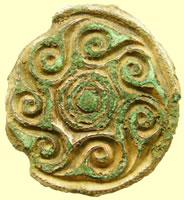 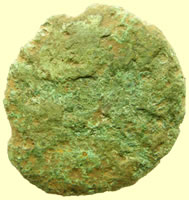 |
 |
||
5th-6th century AD Saxon gilded saucer brooch - running spiral design East Anglian type |
C10thC - Saxon harness cheek piece |
||
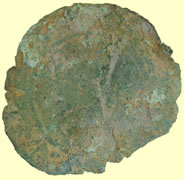 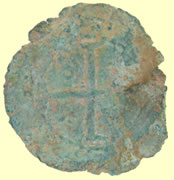 |
  |
||
Medieval jetton |
1stC Roman fibular brooch |
||
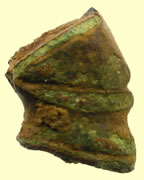 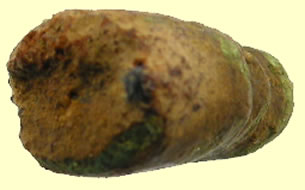 |
  |
||
Roman bronze knife pommel |
1216 Henry III hammered silver short cross penny |
||
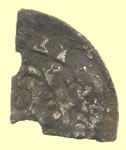 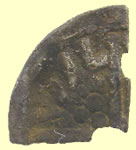 |
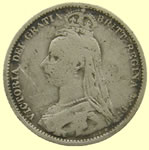 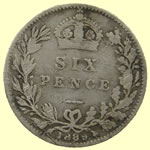 |
||
1216 Henry III hammered silver voided long cross qtr penny |
1889 Victorian milled silver sixpence |
||
  |
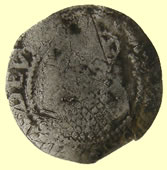 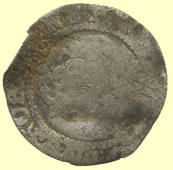 |
||
1216 Henry III hammered silver short cross half penny |
1603 James 1st hammered silver half groat |
||
  |
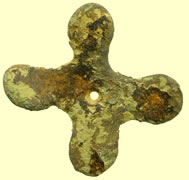 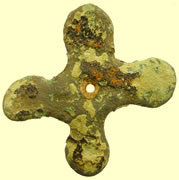 |
||
1906 Edward VII milled silver sixpence |
Medieval mount |
||
 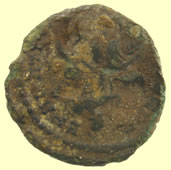 |
 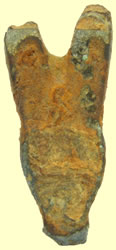 |
||
4thc Roman bronze sent for ID |
Roman animal bronze decorated strapend - 2 rivet fixing |
||
|
|||
Ill Mark's 9 hoard coins |
|||
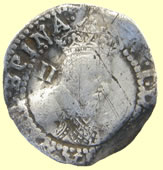 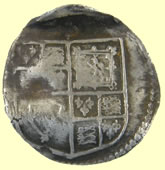 |
  |
||
1603 James 1st hammered silver half groat |
1816 George III milled silver sixpence |
||
|
|||
Fantastic find 1stC BC Celtic bucket mount - The bird probably a raven would be one of a series used as decoration around the top of the bucket. The bucket was used in sacrifial or religious ceremonies In Celtic mythology birds were represented as the messengers of the gods
34.02mm L, 5.28g |
|||
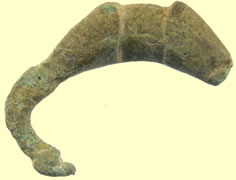 |
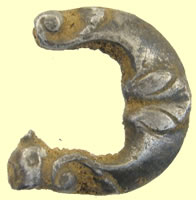 |
||
Roman buckle |
Silver ornate Georgian buckle fragment |
||
 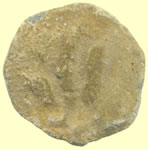 |
|
||
Roman lead token |
C10thC Saxon harness cheek piece |
||
 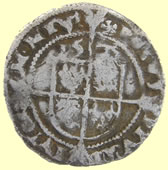 |
|
||
1575 Elizabeth hammered silver 3 pence |
Interesting spur shaped medieval widget - no idea what it was used for yet |
||
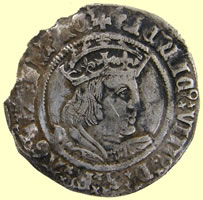 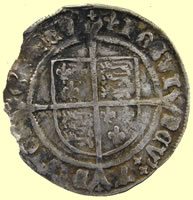 |
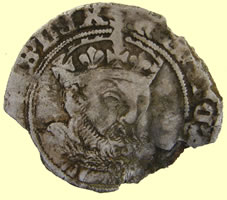 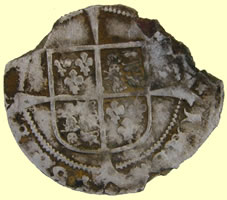 |
||
1526-1544 Henry VIII hammered silver groat - Lis mintmark 2nd issue London POSUI
|
1544- 1547 Henry VIII hammered silver groat -3rd issue London |
||
 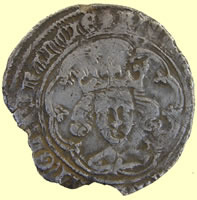 |
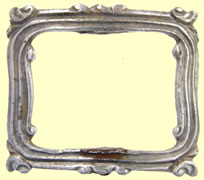 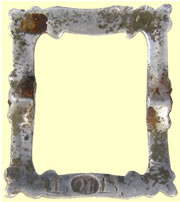 |
||
Rare 1377- 1399 Richard II hammered silver groat - London - New bust wide hair Type 3 - curved serifs |
Solid silver Georgian buckle - Inscribed I.B - Maker OH |
||
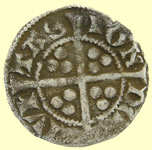 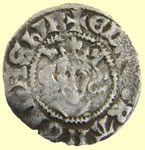 |
 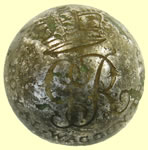 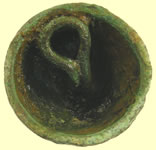 |
||
1341 Edward III hammered silver florin penny -Cross 3 Obv EDWAR ANGL DNS HYB Rev CIVI/TAS/LON/DON - London mint |
Excellent button find - 19thC GR 'Royal Waggon Train' |
||
Solid silver dragon brooch - 1948 London hall mark |
|||
|
|
||
1427-30 Henry VI hammered silver groat - Rosette Mascle issue - Initial mark Cross Potonce - Cross 3a Rev VILLA CALISIE - Calais Mint |
1435- 1438 Henry VI hammered silver penny - Cross 5 - Leaf Tefoil issue Rev VILLA CALISIE - Calais Mint |
||
Roman protected loop terret -(reigns guide) |
|||
 |
 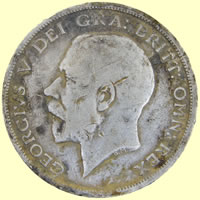 |
||
16thC Tudor duck head buckle |
1920 George V milled silver half crown (30 pence) |
||
 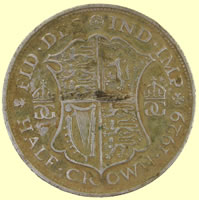 |
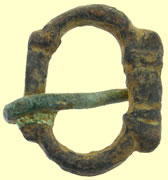 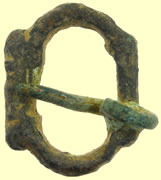 |
||
1929 George V milled silver half crown (30 pence) |
Medieval buckle |
||
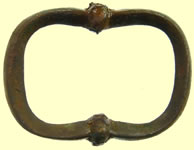 |
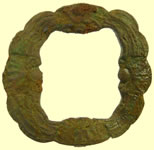 |
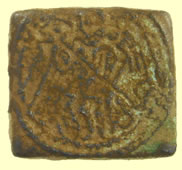 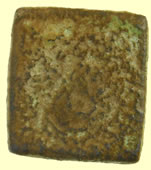 |
|
1550 -1650 buckle |
Georgian buckle | 16thC Antwerp hand coin weight |
|
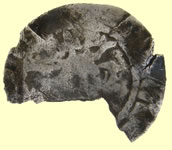 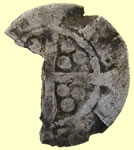 |
 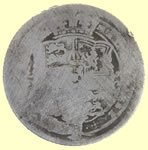 |
||
Medieval hammered silver penny |
1817 George III milled silver sixpence |
||
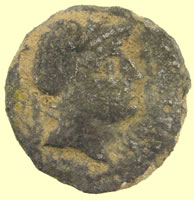 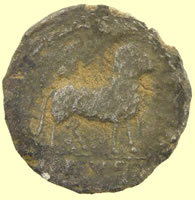 |
|||
Uncleaned Roman BC Republican silver coin sent off for ID 2.46g, 16.61mm
Minimal 'cooking' to bring out detail
I found your denarius - and it is Republican, although fairly late Republican.
L. Rustias, 76 BC.
Obverse: Helmeted head of young Mars right - asterisk-like XVI in monogram below chin, SC behind.
Reverse: Ram standing right, L RVSTI in exergue - RRC 389/1, CRR 783, RSC-Babelon Rustia 1, SR 320.
It's a little unlikely, but not inconcievable that this coin was still in active circulation when Claudius invaded Britain - it certainly would have been current when Caesar made his ill-fated attempts. So it could have come either in pre-Roman trade, or during an early Roman incursion.
Neither particularly rare or particularly common - sort of an in-between type for scarcity.
Mark
|
|||
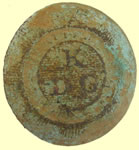 |
 |
Constantius II If it's the soldier & horseman type, it's from around 355-259, if it's the emperor & galley type, it's more like 350-53. Mark
|
|
19thC Kings draggon guards button |
Georgian watch winder |
More hoard Roman bronze coins |
|
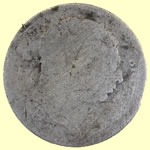 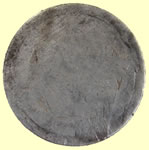 |
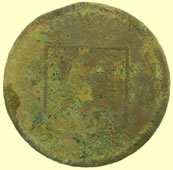 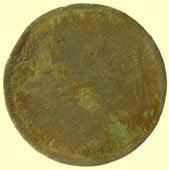 |
||
1816 George III milled silver sixpence |
NORWICH 1811 HALFPENCE TOKEN WITHERS 928 |
||
 |
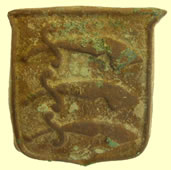 |
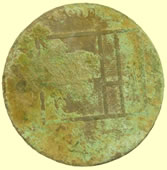 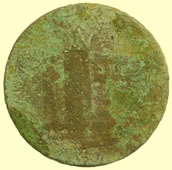 |
|
18thC George III guinea gaming tokem |
20thC Essex county badge |
1794 Colchester half penny OBVERSE: A view of Colchester Castle to the edge of token. Ex: 1794. REVERSE: A weaving loom. SUCCESS TO THE BAY TRADE. EDGE: PAYABLE AT CHARLES HEATHS BAY MAKER COLCHESTER .X. |
|
|
As dug
Starting to 'cook' it |
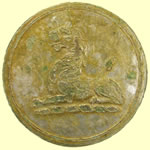 |
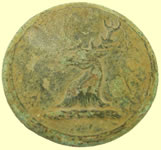 |
|
Roman silver coin - cooking to remove unusual thick green crud |
19thC Livery button |
19thC Livery button |
|
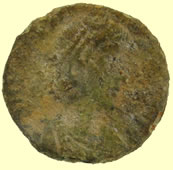 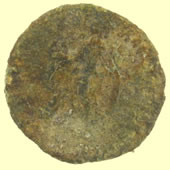 |
 |
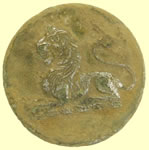 |
|
Mid 4thC Roman House of Constantine bronze coin late Constantius II - I'm pretty sure it's a SPES REIPVBLICE, the last AE type Constantius II minted - emperor standing holding spear and globe. These date to about 359-361 and are only known for Constantius II and Jullian "The Philosopher/Apostate" as Caesar. Mark |
17thC button |
19thC Livery button |
|
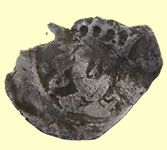 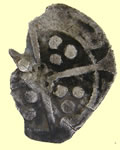 |
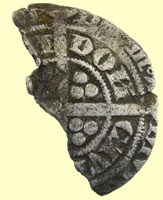 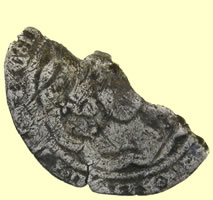 |
||
1461 -70 Edward IV hamnmered silver penny - G & key by bust - York mint - quatrefoil with pellet at centre of reverse cross |
1327 Edward III hammered silver groat Rev CIVI/TAS/LON/DON - London mint |
||
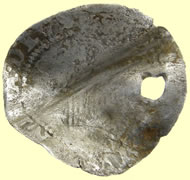 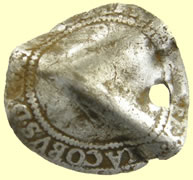 |
  |
||
1603 Irish James 1st hammered silver sixpence |
1415-1497 French Stock jeton of Tournai - Three circle emblem of Tournai Narrow armed single stranded cross fleuretty |
||
  |
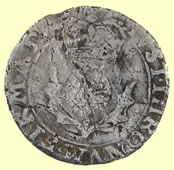 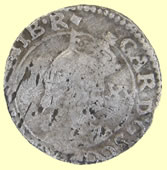 |
||
1216 Henry III hammered silver short cross cut halfpenny |
1634 Charles 1st Scottish hammered silver 20 pence |
||
 |
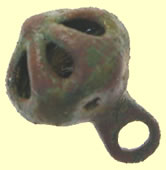 |
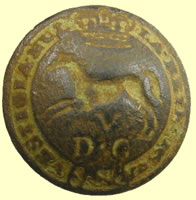 |
|
17thC lead trade token |
16thC Tudor fretwork buckle |
Unrecorded 5th Dragoon guards button Crimera war period |
|
 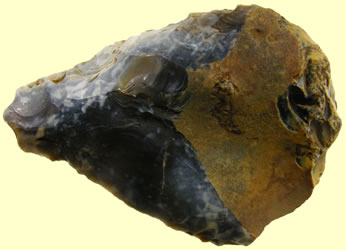 |
|||
11,000 BC flint hand axe |
|||
Roman 1st/2nd C silver coin as dug and 'cooking' to remove crust- You can see how thick this crust is on the lastest pictures of his bust
Well worn Roman BC period Republican silver coin - hopefully there is some detail under the crust after it is 'cooked' |
|||
 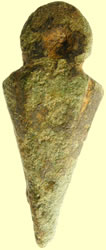 |
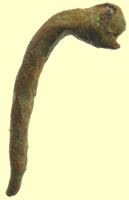  |
||
Roman bronze bucket handle mount |
1stC Roman fibular brooch |
||
|
|||
Interesting medieval strap fitting - 2 rivet fixings |
|||
  |
 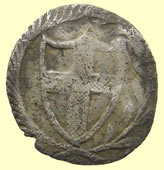 |
||
George V Indian milled silver 2 Annas |
1649 Commonwealth hammered silver half groat |
||
 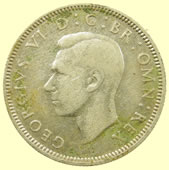 |
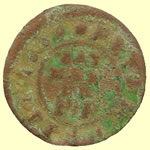 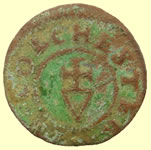 |
||
1946 George VI milled silver shilling (12 pence) |
1669 Peter Pelle, bay maker of Colchester Essex hammered copper trade farthing Ref Norweb 1209a |
||
|
|||
18thC Georgian silver spur fitting with markers name CH Charles Hougham - London Charles Hougham registered his first mark on 11th January 1769 as a small-worker. He went on to register a number of marks as a buckle-maker and then other marks from 1785 as a plate-worker. He died in 1793 aged only 44 |
|||
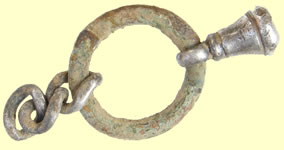 |
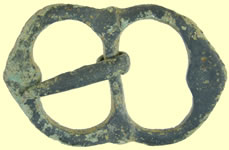 |
||
Part Georgian silver fob chain |
1550 -1650 buckle |
||
  |
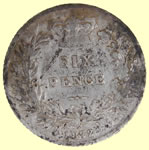 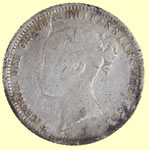 |
||
1247 Henry III hammered silver voided long cross cut half penny - Class 2b Obv HENRICVS REX Rev hE(N/RI/ONO/XON - Moneyer HeNri of Oxford mint |
1872 Victorian milled silver 6 pence |
||
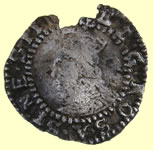 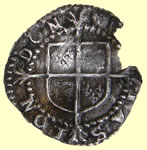 |
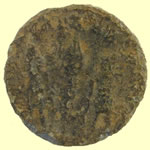 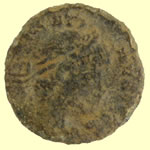 |
||
1560 Elizabathe hammered silver penny |
Mid 4thC Roman House of Constantine bronze coin |
||
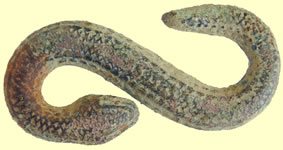 |
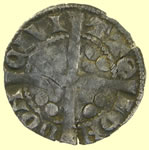 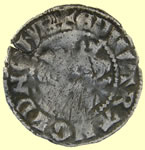 |
||
19thC snake buckle |
1341 Edward III hammered silver florin penny -Cross 3 Obv EDWAR ANGL DNS HYB Rev CIVI/TAS/LON/DON - London mint |
||
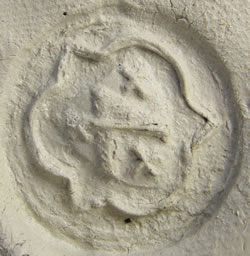 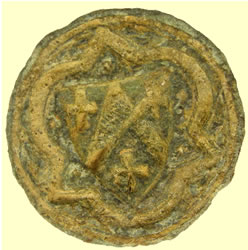 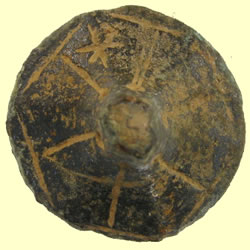 |
|||
Fantastic circa 13thC Medieval seal matrix with heraldic shield impression - this seal is first I have seen with additional decoration on the 'bell' top It will be interesting if we can find the family crest and who it belonged to Ok, here is my best guess. Cal Jim
|
|||
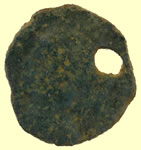 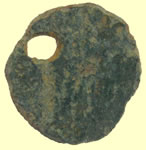 |
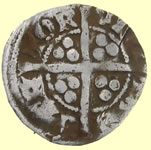 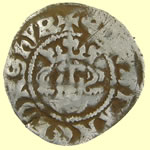 |
||
5th/6thC Saxon pendant - they used Roman coins like this 4thC example as necklaces |
1341 Edward III hammered silver florin penny -Cross 3 Obv EDWAR ANGL DNS HYB Rev CIVI/TAS/CAN/TOR - Canterbury mint |
||
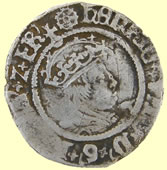 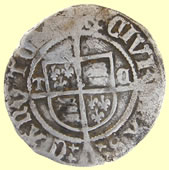 |
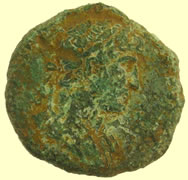 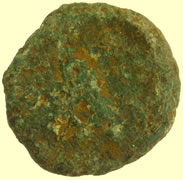 |
||
1533-44 Henry VIII hammered silver half groat - Catherine wheel mint mark Archbishop Cranmer - TC besides shield |
2nd C Roman bronze sent for ID I believe the one with the nicer portrait is an As of Hadrian - 117-138 AD. The portrait is in the style I associate with the earlier years of his reign - his older busts make him look a bit more "chunky" and seldom show much of a neck or shoulders.
Here's an example of a portrait of Hadrian in a style quite similar to what you see on your coin: http://www.stoa.org/gallery/album92/Hadrian_Virtus_Dup
Mark
|
||
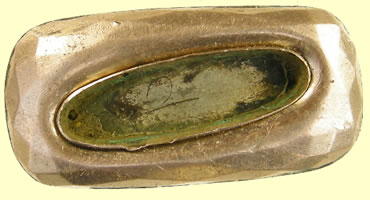 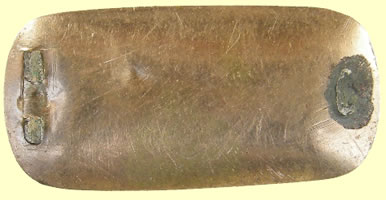 |
|||
Georgian gold brooch - no hall marks but note the number 2 inscribed where the stone would have been |
|||
c 600/800 AD Saxon gold coin send to Fitzwilliam museum for ID and recording 1.35g, 13.87mm 'Saxon' gold coins not in the reference books are usually Merovingian tremisses, and this coin (EMC 2010.0130) is no exception to this rule. Merovingian gold coins greatly outnumber Anglo-Saxon gold coins as finds in England. With thanks, Martin |
|||
1.26g,15.08mm |
|||
2nd Saxon gold coin found in same location as the one above - reported to Colchester museum as potential hoard Merovingian tremissis of the 7th century 1.26g,15.08mm This coin (EMC 2010.0131) is a Merovingian tremissis of Coutances (dep. Keep looking. Martin
|
|||
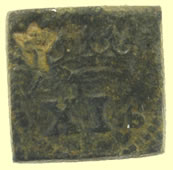 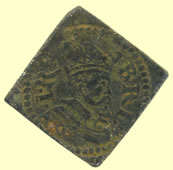 |
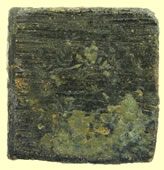 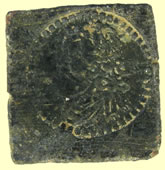 |
||
1604-19 Coin weight for a Gold Double Crown of James 1st - 2nd coinage revalued 5.0g |
1619-25 Coin weight for a Gold Half Laural of James 1st - 3rd coinage
4.5g |
||
|
|||
Huge Roman bronze animal head mount - possible bucket or pot mount - looks like it is a bird with a hooked beak but it could also be an elephant 80.24g, 29.32mm L x 28.5mm dia
|
|||
Saxon C600 - 775 AD Silver Sceattas Porcupine Type - sent to Fitzmuseum for confirmation and recording Many thanks for this Series E (variety G3), which I have recorded as eMC 2010.0133. Martin 1.20g, 12.26mm |
|||
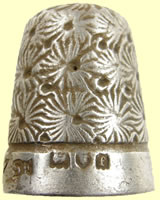 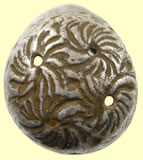 |
 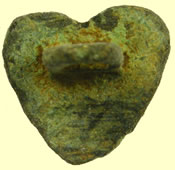 |
||
1901 London hall marked solid silver thimble |
Excellent c 1603 James 1st button - Inscribed James Rex |
||
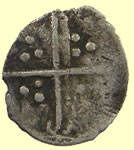 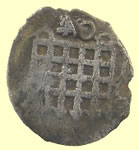 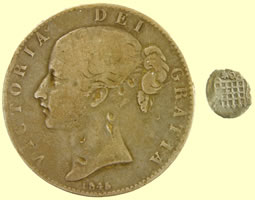 |
|||
Tiny 1603 James 1st hammered silver half penny - First issue Victorian crown for size comparison |
|||
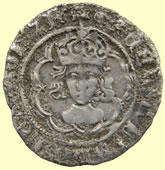  |
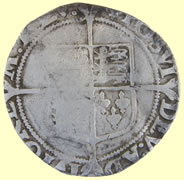 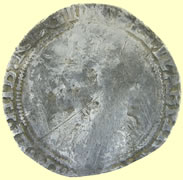 |
||
1493 -1498 Henry VII hammered silver half groat - crown, one arch jewelled, one arch unjewelled - Type 3b Rev CIVI/TAS/CAN/TOR - Canterbury mint |
1566-7 Elizabeth hammered silver sixpence |
||
 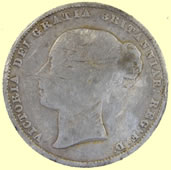 |
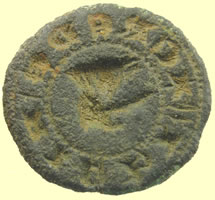 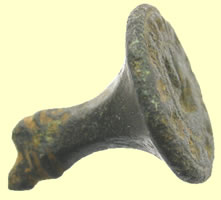 |
||
1859 Victoria milled silver shilling |
Medieval seal matrix |
||
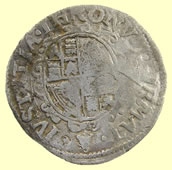 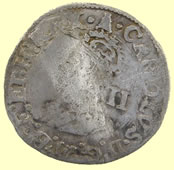 |
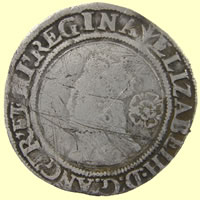 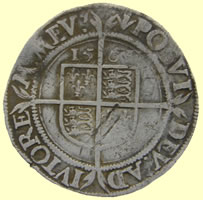 |
||
1634-5 Charles 1st hammered silver half groat - Tower mint under Charles - Bell mint mark |
1561 Elizabeth 1st hammered silver shilling ( 12 pence) - Phoen mint mark |
||
  |
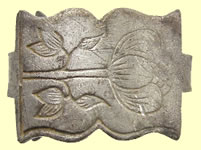 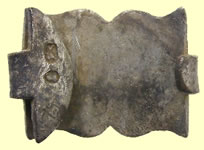 |
||
1697 William III milled silver sixpence |
18thc solid silver decorated clog fastner - PB over AB markers mark London and bust hall marks Peter & Ann Bateman PB/AB. 1791 - 1800 Bateman workshop at Bunhill Row London 1794 |
||
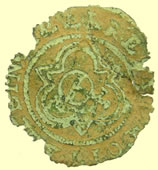 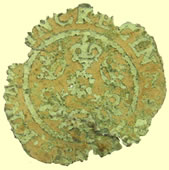 |
 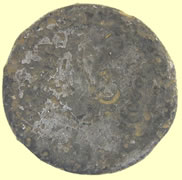 |
||
1586 Hans Krauwincel II Rose orb Jeton HANNS KRAVWINCKEL IN NVRENB |
Another Roman silver straight into the 'cooker' this appears to be a 32BC Tribute penny |
||
 |
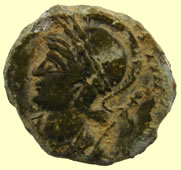 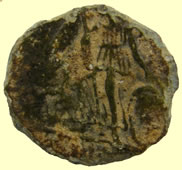 |
||
Medieval heraldic quadrefoil hanging pendant - This was originally thick with a hard crust and I have had this soaking in distilled water for several days. You can see a central box with 4 fleur de Lis appearing. I am hoping the green enamelling is intact under the crust so I am being mega careful |
4thC Roman bronze sent for ID |
||
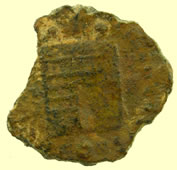 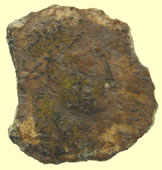 |
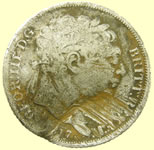 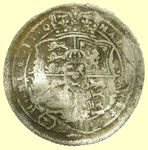 |
||
4thC Roman bronze sent for ID |
1817 George III milled islver sixpence |
||
 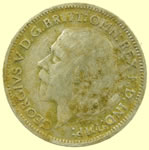 |
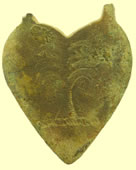 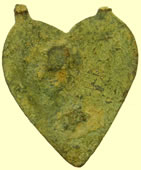 |
||
1935 George V milled silver sixpence |
18thC strap guide - 2 missing integral lugs |
||
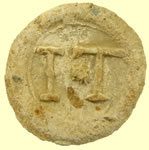 |
 |
|
|
17thC lead trade token |
Military badge - not sure of reg yet |
Interesting post medieval buckle |
|
|
 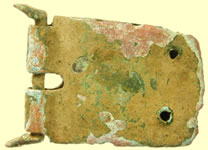 |
||
18thC musket plate |
Medieval buckle with plate - 4 rivet fixings |
||
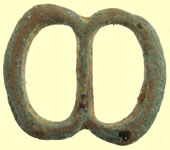 |
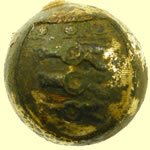 |
 |
|
1550 -1650 buckle |
18thC officer's Royal artillery button |
Georgian watch winder |
|
  |
|||
Very interesting medieval fixed buckle/strap fitting with knoped end decoration - 2 rivet fixings |
|||
1560-61 Elizabeth 1st gold half crown - mintmark cross crosslet - 0.994 fine gold 1.40g, 18.63mm |
|||
|
|
|||
